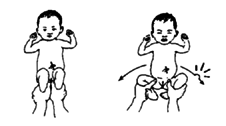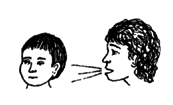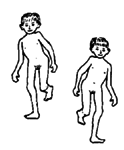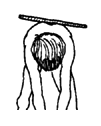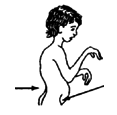Disabled Village Children
A guide for community health workers,
rehabilitation workers, and families
PART 1
WORKING WITH THE CHILD AND FAMILY:
Information on different Disabilities
B. Recognizing, Helping with, and Preventing Common Disabilities
CHAPTIER 6
Guide for Identifying Disabilities
This chapter has a chart, 7 pages long, to help you find out what disability a child possibly has, and where to look up that disability in this book.
In the first column of the chart, we list the more noticeable signs of different disabilities. Some of these signs are found in more than one disability. So in the second column we add other signs that can help you tell apart similar disabilities. The third column names the disability or disabilities that are most likely to have these signs. And the fourth column gives the page numbers where you should look in this book. (Where it says WTND and then a number, this refers to the page in Where There Is No Doctor.)
If you do not find the sign you are looking for in the first column, look for another sign. Or check the signs in the second column.
This chart will help you find out which disabilities a child might have. It is wise to look up each possibility. The first page of each chapter on a disability describes the signs in more detail.
|
IMPORTANT: Some disabilities can easily be confused. Others are not included in this book. When you are not sure, try to get help from someone with more experience. At times, special tests or X-rays may be needed to be sure what the problem is. |
Fortunately, it is not always necessary to know exactly what disability a child has. For example, if a child has developed weakness in his legs and you are not sure of the cause, you can still do a lot to help him. Read the chapters on disabilities that cause similar weakness, and the chapters on other problems that the child may have. For this child, you might find useful information in the chapters on polio, contractures, exercises, braces, walking aids or wheelchairs, and many others.
Sometimes it is important to identify the specific disability. Some disabilities require specific medicines or foods-for example, night blindness, rickets, or cretinism. Others urgently need surgery - for example, spina bifida or cleft lip and palate. Others require special ways of doing therapy or exercises-for example, cerebral palsy. And others need specific precautions to avoid additional problems-for example, spinal cord injury and leprosy. For this reason, it helps to learn as much about the disability as you can. Whenever possible, seek information and advice from more experienced persons. (However, even experts are not always right. Do not follow anyone's advice without understanding the reasons for doing something, and considering if and why the advice applies to the individual child.)

In addition to this chart, 2 other guides for identifying disabilities are in this book :
GUIDE FOR IDENTIFYING CAUSES OF JOINT PAIN, Page 130. GUIDE FOR IDENTIFYING AND TREATING DIFFERENT FORMS OF FITS (EPILEPSY), Page 240.
GUIDE FOR IDENTIFYING DISABILITIES
SIGNS PRESENT AT OR SOON AFTER BIRTH
|
IF THE CHILD HAS THIS |
AND ALSO THIS |
HE MAY HAVE |
SEE PAGE |
|
born weak or 'floppy' 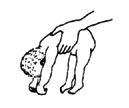
slow to begin to lift head or move arms.
|
|
|
87
277 |

|
|
279
282 |
|

small head, or small top part of head |
microcephalia (small brain) mental retardation |
278 | |
|
none of above |
developmental delay for other reasons |
289 | |
|
does not suck well or chokes on milk or food 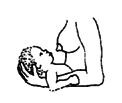
|
|
cerebral palsy |
87 |
|
|
120
277 |
|
|
one or both feet turned in or back. 
|
no other signs |
club foot |
114 |

|
arthrogryposis |
122 | |
|
dark lump on back |
spina bifida |
167 | |
|
'bag' or dark lump on back 
|

|
spina bifida |
167 |
|
head too big; keeps growing. 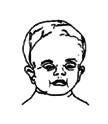
|
may develop: 
|
hydrocephalus (water on the brain) |
169 |
|
At birth, this is usually a sign of spina bifida. |
167 | ||
|
in an older child, possibly tapeworm in brain, or a brain tumor |
WTND 143 | ||
|
upper lip and/or roof of mouth incomplete. 
|

|
cleft lip (hare lip) and cleft palate |
120 |
|
birth deformities, defects, or missing parts. 
|
(may or may not be associated with other problems) |
See
|
119
227 279 287 |
|
abnormal stiffness or position. 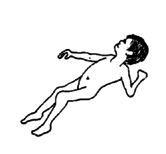
|
|

arthrogryposis |
122 |
|
spastic cerebral palsy Note: muscle tightness(spasticity) usually does not appear until weeks or months after birth. |
89 |
|
IF THE CHILD HAS THIS |
AND ALSO THIS |
HE MAY HAVE |
SEE PAGE |
|
one arm weak or in strange position 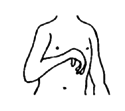
|
does not move the arm much 
|
Erb's palsy (weakness from damage to nerves in shoulder during birth) |
127 |
|
leg on same side often affected |
hemiplegic (one-sided) cerebral palsy |
90 | |
|
dislocated hip at birth. 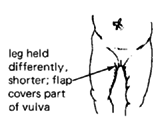
|
On opening legs like this, leg 'pops' into place or does not open as far.
|
dislocated hip from birth (often both hips) may be present with:
Also see Page 156. |
155
167 279 122 |
|
slow to respond to sound or to look at things
|
(may be due to one or a combination of problems) |
Check for signs of:
|
290
87 243 257 |
SIGNS IN CHILDREN
|
IF THE CHILD HAS THIS |
AND ALSO THIS |
HE MAY HAVE |
SEE PAGE |
|
slower than other children to do things (roll, sit, use hands, show interest, walk, talk) 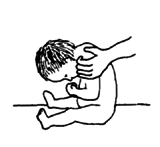
|
slow in most or all areas: |
Developmental delay, check for signs of: |
287 |

|
Down syndrome (mongolism) |
279 | |

|
cretinism |
282 | |
|
has continuous strange movements positions, and/or stiffness |
cerebral palsy also cheek for:
|
87
243 257 320 |
|
|
does not respond to sounds, does not begin to speak by age 3
|
may respond to some sounds but not others Check for ear infection (pus). |
Check for:
|
257
283 87 |
|
does not turn head to look at things, or reach for things until they touch her 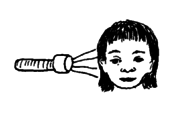
|
Eyes may or may not look normal. |
|
243
277 87 |
|
Eyelids or eyes make quick, jerky, or strange movements. 
|
Check for one or a combination of these. |
|
243
233 15 87 14 |
|
IF THE CHILD HAS THIS |
AND ALSO THIS |
HE MAY HAVE |
SEE PAGE |
|
All or part of body makes strange, uncontrolled movements. 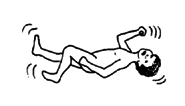
|
|
epileptic fits |
233 |

slow, sudden, or rhythmic movements; fairly continuous (except in sleep);no loss of consciousness |
athetoid cerebral palsy (Note: Fits and cerebral palsy may occur in the same child.) |
89 | |
|
Body, or parts of it, stiffens when in certain positions: poor control of some or all movements. |

|
spastic cerebral palsy |
89 |
PARTS OF BODY WEAK OR PARALYZED
|
IF THE CHILD HAS THIS |
AND ALSO THIS |
HE MAY HAVE |
SEE PAGE |
|
floppy or limp weakness in part or all of body no loss of feeling in affected parts no spasticity (muscles that tighten without control) normal at birth |

|
polio |
59 |

|
|
109
112 |
|

|
tick paralysis 
Guillain-Barre' paralysis (usually temporary) paralysis from pesticides, chemicals, foods (lathyrism) |
not in book 6215 |
|
|
lump on back (See Page 57.) |
tuberculosis of spine |
165 | |
|
floppy or limp weakness usually some loss of feeling |

|
leprosy |
215 |
|
spina bifida |
167 | |
|
spinal cord injury 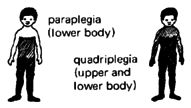
|
175 | |
|
injury to nerves going to one part of body |
hand weakness sometimes caused by using crutches wrongly |
393 |
|
IF THE CHILD HAS THIS |
AND ALSO THIS |
HE MAY HAVE |
SEE PAGE |
|
weakness usually with stiffness or spasticity of muscles no loss of feeling |
usually affects body in one of these patterns
Muscles tighten and resist movement because of joint pain. |
JOINT PAIN (many causes-see below) |
87
130 |
JOINT PAIN
|
IF THE CHILD HAS THIS |
AND ALSO THIS |
HE MAY HAVE |
SEE PAGE |
|
one or more painful joints |

|
juvenile arthritis |
135 |
|
other causes of joint pain See chart on joint pain. |
130 |
WALKS WITH DIFFICULTY OR LIMPS
|
IF THE CHILD HAS THIS |
AND ALSO THIS |
HE MAY HAVE |
SEE PAGE |
|
dips to one side with each step 
|
one leg often weaker and shorter |
Check for:
|
59
87 155 |
|
damaged hip joint |
157 | |
|
walks with knees pressed together 
|
|
spastic diplegic or paraplegic cerebral palsy |
87 |
|
stands and walks with knees together and feet apart 
no other problems |

feet less than 3" apart at age 3 |
normal from ages 2 to 12 |
113 |

feet more than 3" apart at age 3 |
knock-kneed |
114 | |
|
walks awkwardly with one foot tiptoe 
|
muscle spasms and poor control on that side. Hand on that side often affected. |
hemiplegic cerebral palsy |
90 |
|
(stroke in older persons) |
not in book |
||
|
walks awkwardly with knees bent and legs usually separated
|
jerky steps, poor balance sudden, uncontrolled movements that may cause failing |
athetoid cerebral palsy |
89 |
|
slow 'drunken' way of walking learns to walk late and falls often |
|
90
279 282 |
|
|
walks with both feet tiptoe
|
|
muscular dystrophy |
109 |
|
legs and feet stiffen (spasticity of muscle) |
spastic cerebral palsy |
89 | |
|
no other problems |
normal? (some normal children at first walk on tiptoes) |
292 |
|
IF THE CHILD HAS THIS |
AND ALSO THIS |
HE MAY HAVE |
SEE PAGE |
|
walks with hand(s) pushing thigh(s) or with knee(s) bent back
|
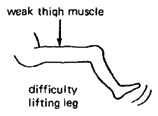
|
|
59
109 135 112 |
|
Foot hangs down weakly (foot drop).
|

Child lifts foot high with each step so that it will not drag. |
|
59
167 109 112 35 139 |
|
dips from side to side with each step
|
due to muscle weakness at side of hips, or double dislocated hips, or both |
|
59
87 167 279 109 126 122 155 |
|
walks with one (or both) hip, knee, or ankle that stays bent
|
joints cannot be slowly straightened when child relaxes (see page 79). |
may be secondary to:
|
77
80 59 131 231 |
|
Joints can gradually be straightened when child relaxes. |
spasticity, often cerebral palsy |
89 | |
|
Knees wide apart when feet together (bow legs). Waddles or dips from side to side (if he walks).
|
under 18 months old |
often normal |
113 |
|
Any combination of these:
|
Consider:
|
125
125 126 282 279 155 |
|
|
flat feet
|
no pain or other problems |
normal in many children |
113 |
|
may be problems in:
|
87
59 167 279 |
BACK CURVES AND DEFORMITIES
|
IF THE CHILD HAS THIS |
AND ALSO THIS |
HE MAY HAVE |
SEE PAGE |
|
sideways curve of backbone
|
When child bends over, look for a lump on one side.
|
'scoliosis' - may occur alone or as complication of: polio cerebral palsy muscular dystrophy spina bifida other physical disability |
59 87 109 167 162 |
|
IF THE CHILD HAS THIS |
AND ALSO THIS |
HE MAY HAVE |
SEE PAGE |
|
swayback
|
|
'lordosis' - may occur in:
|
59
167 87 109 279 282 126 161 |
|
rounded back
|
'kyphosis' - often occurs with:
|
136 175 59 125 |
|
|
hard, sharp bend of or bump in backbone 
|
|
tuberculosis of the spine |
165 |
|
dark soft lump over backbone 
|
|
spina bifida ('sack on the back') |
167 |
OTHER DEFORMITIES
|
IF THE CHILD HAS THIS |
AND ALSO THIS |
HE MAY HAVE |
SEE PAGE |
|
missing body parts |

born that way |
born with missing or incomplete parts |
121 |

accidental or surgical loss of limbs (amputation) |
amputations |
227 | |

gradual loss of fingers, toes, hands, or feet, often in persons who lack feeling |
sometimes seen with
|
159
215 167 |
|
|
hand problems (For hand problems from birth, see Page 305) |

|
may occur with:
All may lead to contractures. |
59
109 112 175 215 127 |
|
spastic cerebral palsy may lead to contractures |
89 | |
|
burn scars and deformities |
burns |
231 | |
|
clubbing or bending of feet (For club feet from birth, see Page 114.) |
may begin as floppy weakness and become stiff from contractures, if not prevented 
|
may occur with many physical disabilities, including:
|
59
87 167 109 139 175 |
DISABILITIES THAT OFTEN OCCUR WITH
OR ARE SECONDARY TO OTHER DISABILITIES
|
IF THE CHILD HAS THIS |
AND ALSO THIS |
HE MAY HAVE |
SEE PAGE |
|
Developmental delay: child slow to learn to use her body or develop basic skills 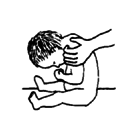
|
caused by slow or incomplete brain function or by severe physical disability, or both |
often seen in:
|
277
87 283 |
|
caused by overprotection: treating children like babies when they could do more for themselves |
some delay can occur with almost any disability |
287 | |
|
Contractures joints that no longer straighten because muscles have shortened 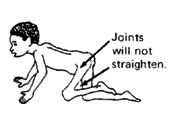
|
|
often secondary to:
|
59 87 167 135 109 127 227 215 |
|
sometimes due to scarring from burns or injuries |
burns |
231 | |
|
Behavior problems 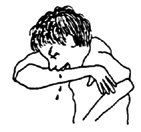
|
may come from:
(Some children with epilepsy from brain damage may pull out hair, bite themselves, etc.) |
behavior problems common with:
and for emotional reasons, with:
|
277
233 87 175 109 257 365 |
|
Slow to learn certain things only; otherwise intelligent. |
|
learning disability |
365 |
|
Speech and communication problems |
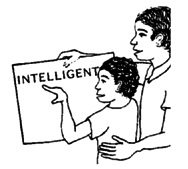
but still cannot speak. |
may occur with:
(Deafness may occur together with these and other disabilities.) |
257
287 87 279 282 126 125 120 |
|
other problems that sometimes occur secondary to other disabilities (Some of these we have already included in this chart.) |
Main disability
|
Common secondary disabilities
|
243 257 233 |
|
|
161 | |
|
|
195
159 203 |
Disabled Village Children
A guide for community health workers,
rehabilitation workers, and families
by David Werner
Published by
The Hesperian Foundation
P.O. Box 11577
Berkeley, CA 94712-2577

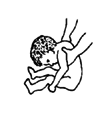
 may grip thumb tightly
may grip thumb tightly